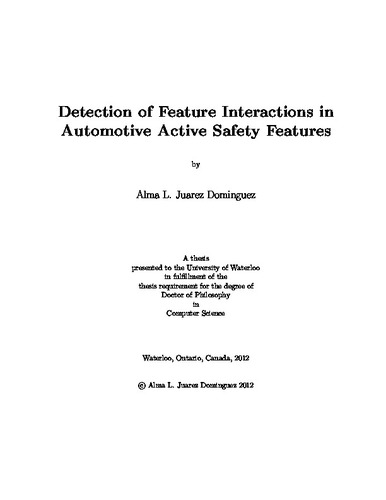| dc.description.abstract | With the introduction of software into cars, many
functions are now realized with reduced cost,
weight and energy. The development of these software
systems is done in a distributed manner independently
by suppliers, following the traditional approach of
the automotive industry, while the car maker takes
care of the integration. However, the integration can
lead to unexpected and unintended interactions among
software systems, a phenomena regarded as feature
interaction. This dissertation addresses the problem
of the automatic detection of feature interactions
for automotive active safety features.
Active safety features control the vehicle's motion
control systems independently from the driver's request,
with the intention of increasing passengers' safety
(e.g., by applying hard braking in the case of an
identified imminent collision), but their unintended
interactions could instead endanger the passengers
(e.g., simultaneous throttle increase and sharp narrow
steering, causing the vehicle to roll over).
My method decomposes the problem into three parts:
(I) creation of a definition of feature interactions
based on the set of actuators and domain expert knowledge;
(II) translation of automotive active safety features
designed using a subset of Matlab's Stateflow into the
input language of the model checker SMV;
(III) analysis using model checking at design time to
detect a representation of all feature interactions
based on partitioning the counterexamples into
equivalence classes.
The key novel characteristic of my work is exploiting
domain-specific information about the feature interaction
problem and the structure of the model to produce a
method that finds a representation of all different
feature interactions for automotive active safety
features at design time.
My method is validated by a case study with the set
of non-proprietary automotive feature design models
I created. The method generates a set of counterexamples
that represent the whole set of feature interactions in
the case study.By showing only a set of representative
feature interaction cases, the information is concise
and useful for feature designers. Moreover, by generating
these results from feature models designed in Matlab's
Stateflow translated into SMV models, the feature
designers can trace the counterexamples generated by SMV
and understand the results in terms of the Stateflow
model. I believe that my results and techniques will
have relevance to the solution of the feature
interaction problem in other cyber-physical systems,
and have a direct impact in assessing the safety of
automotive systems. | en |

